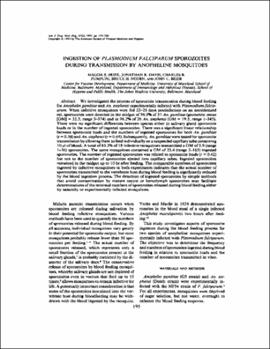| dc.contributor.author | Beier, Magda S. | |
| dc.contributor.author | Davis, Jonathan R. | |
| dc.contributor.author | Pumpuni, Charles B. | |
| dc.contributor.author | Noden, Bruce H. | |
| dc.contributor.author | Beier, John C. | |
| dc.date.accessioned | 2022-04-12T13:47:20Z | |
| dc.date.available | 2022-04-12T13:47:20Z | |
| dc.date.issued | 1992 | |
| dc.identifier | oksd_noden_ingestionofplasmodiumfalciparum_1992 | |
| dc.identifier.citation | Beier, M. S., Davis, J. R., Pumpuni, C. B., Noden, B. H., & Beier, J. C. (1992). Ingestion of Plasmodium falciparum sporozoites during transmission by anopheline mosquitoes. American Journal of Tropical Medicine and Hygiene, 47(2), pp. 195-200. https://doi.org/10.4269/ajtmh.1992.47.195 | |
| dc.identifier.uri | https://hdl.handle.net/11244/335160 | |
| dc.description.abstract | We investigated the process of sporozoite transmission during blood feeding for Anopheles gambiae and An. stephensi experimentally infected with Plasmodium falciparum. When infective mosquitoes were fed 22-25 days postinfection on an anesthetized rat, sporozoites were detected in the midgut of 96.5% of 57 An. gambiae (geometric mean [GM] = 32.5, range 3-374) and in 96.2% of 26 An. stephensi (GM = 19.5, range 1-345). There were no significant differences between species either in salivary gland sporozoite loads or in the number of ingested sporozoites. There was a significant linear relationship between sporozoite loads and the numbers of ingested sporozoites for both An. gambiae (r = 0.38) and An. stephensi (r = 0.69). Subsequently, An. gambiae were tested for sporozoite transmission by allowing them to feed individually on a suspended capillary tube containing 10 ul of blood. A total of 83.3% of 18 infective mosquitoes transmitted a GM of 5.9 (range 1- 36) sporozoites. The same mosquitoes contained a GM of 23.4 (range 2-165) ingested sporozoites. The number of ingested sporozoites was related to sporozoite loads (r = 0.42) but not to the number of sporozoites ejected into capillary tubes. Ingested sporozoites remained in the midgut up to 10 hr after feeding. The comparable numbers of sporozoites ingested by infective mosquitoes in both experiments indicates that the actual number of sporozoites transmitted to the vertebrate host during blood feeding is significantly reduced by the blood ingestion process. The detection of ingested sporozoites by simple methods that avoid contamination by mature oocyst or hemolymph sporozoites may facilitate determinations of the minimal numbers of sporozoites released during blood feeding either by naturally or experimentally infected mosquitoes. | |
| dc.format | application/pdf | |
| dc.language | en_US | |
| dc.publisher | American Society of Tropical Medicine and Hygiene | |
| dc.relation.ispartof | American Journal of Tropical Medicine and Hygiene, 47 (2) | |
| dc.relation.uri | https://www.ncbi.nlm.nih.gov/pubmed/1503188 | |
| dc.rights | This material has been previously published. In the Oklahoma State University Library's institutional repository this version is made available through the open access principles and the terms of agreement/consent between the author(s) and the publisher. The permission policy on the use, reproduction or distribution of the material falls under fair use for educational, scholarship, and research purposes. Contact Digital Resources and Discovery Services at lib-dls@okstate.edu or 405-744-9161 for further information. | |
| dc.subject.mesh | Animals | |
| dc.subject.mesh | Anopheles | |
| dc.subject.mesh | Insect Vectors | |
| dc.subject.mesh | Malaria, Falciparum | |
| dc.subject.mesh | Plasmodium falciparum | |
| dc.subject.mesh | Rats | |
| dc.subject.mesh | Rats, Inbred Lew | |
| dc.title | Ingestion of Plasmodium falciparum sporozoites during transmission by anopheline mosquitoes | |
| dc.date.updated | 2022-04-07T15:19:07Z | |
| osu.filename | oksd_noden_ingestionofplasmodiumfalciparum_1992.pdf | |
| dc.description.peerreview | Peer reviewed | |
| dc.identifier.doi | 10.4269/ajtmh.1992.47.195 | |
| dc.description.department | Entomology and Plant Pathology | |
| dc.type.genre | Article | |
| dc.type.material | Text | |
| dc.subject.keywords | Vector-Borne Diseases | |
| dc.subject.keywords | Rare Diseases | |
| dc.subject.keywords | Malaria | |
| dc.subject.keywords | Infectious Diseases | |
| dc.subject.keywords | 2.2 Factors relating to the physical environment | |
| dc.subject.keywords | Infection | |
| dc.subject.keywords | 3 Good Health and Well Being | |
| dc.subject.keywords | 11 Medical and Health Sciences | |
| dc.subject.keywords | Tropical Medicine | |
| dc.identifier.author | ScopusID: 7006044128 (Beier, MS) | |
| dc.identifier.author | ScopusID: 7405963291 (Davis, JR) | |
| dc.identifier.author | ScopusID: 6602672869 (Pumpuni, Charles B.) | |
| dc.identifier.author | ORCID: 0000-0002-0096-370X (Noden, BH) | |
| dc.identifier.author | ScopusID: 6601968347 (Noden, BH) | |
| dc.identifier.author | ScopusID: 7102003162 (Beier, JC) | |
